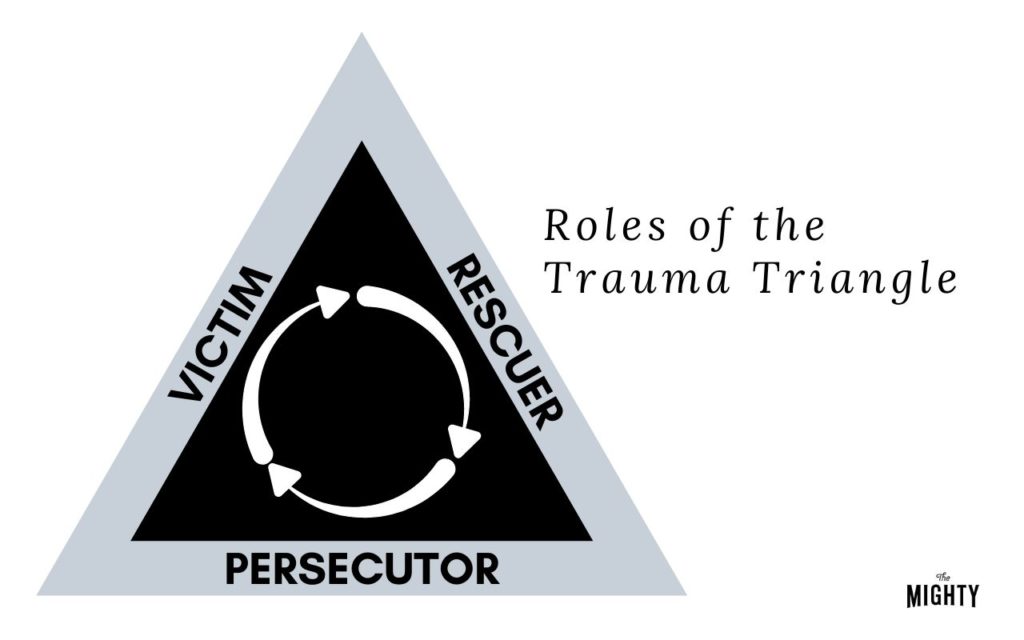Most people who experience trauma develop emergency coping methods in the moment to survive. Those trauma survival skills aren’t helpful long-term but they get stuck anyway. Years later, you may find yourself reacting in ways similar to how you did during the initial trauma without recognizing it. Instead of helping you survive, now these patterns contribute to issues in your relationships.
So much of trauma — like physical, emotional or sexual abuse — is relational. Learning how the “trauma triangle” and its three roles play out in your life may help you understand and change how old trauma coping habits are impacting your relationships today.
What Is the Trauma Triangle?
The trauma triangle is a way to understand and describe the “roles or patterns that trauma survivors reenact in their present relationships,” according to Jenny TeGrotenhuis, LMHC. Stephen Karpman, M.D., developed the concept as the drama triangle, which was later adapted as the trauma triangle by the therapeutic spiral method, a modified form of psychodrama.
The three typical roles in the trauma triangle include the victim, rescuer and perpetrator or persecutor. Trauma survivors will enact all three roles at different times. Each trauma triangle role is a product of the fight-flight-freeze-fawn survival response experienced during trauma.
“The body and mind experience them as emotionally real and relevant in the present, even though they are no longer needed for survival, nor are they appropriate in the present circumstances,” TeGrotenhuis, a certified Gottman therapist and certified clinical trauma professional, told The Mighty. “Trauma survivors will follow their scripts because it feels essential to do so, since these parts of the nervous system are linked to our survival mechanisms.”

What Are the Roles in the Trauma Triangle?
The trauma triangle’s roles help describe how old patterns stick with you years after the trauma is over. Trauma survivors may tend toward the behaviors and relating patterns of one role in the triangle. But most survivors will cycle through all the roles depending on what’s triggered in a relationship.
Shawntres Parks, LMFT, a couples- and trauma-focused therapist with Couples Learn, described each role in detail:
- The Victim role is disempowered, and often feels taken advantage of. The Victim typically embodies hopelessness and helplessness, feeling as if they have no control over their internal and external worlds.
- The Perpetrator is the part that holds anger around the traumatic event. These feelings of anger and brutality can be directed inward or outward when in the Perpetrator role.
- The Rescuer abandons themselves and experiences feelings of unworthiness, having not been rescued at the point of their trauma. Shaming and not taking responsibility are hallmarks of this role and they often take on enabling behaviors in relationships.
A fourth role, the abandoning authority role, is also often included in this model of understanding trauma’s impact on relationships. TeGrotenhuis described the abandoning authority role this way: “When a parent or caregiver turned away from our needs or even put us in harm’s way, we’ll continue to play that role toward ourselves or others in our care.” This could be a parent who didn’t protect you from abuse that you now enact by not taking action to protect yourself in present-day relationships.
How Does the Trauma Triangle Work?
Understanding how your patterns of relating fit into the trauma triangle — and how all three roles fuel each other — can provide more insight into the ways old trauma habits are getting in the way of your relationships now. No matter which trauma triangle role you’re in, they’re all a reaction to feeling completely powerless in past situations.
“The three roles of the trauma triangle fuel one another,” Parks told The Mighty. “Each role has the illusion of being protective, a way to defend oneself from further trauma; however, the reality is that each role keeps a survivor stuck in the traumatic experience.”
TeGrotenhuis explained if your partner was emotionally abused and neglected as a child, he might embody the persecutor role toward you through anger and yelling. This could trigger your victim response role as a trauma survivor, and you shut down to cope with the scary feelings triggered by your partner’s anger. Your partner may feel abandoned when you shut down, which can trigger his victim role. You may then try to rescue him by making excuses for his aggressive behavior.
How Do You Get Out of the Trauma Triangle?
As a trauma survivor, it may not feel good to hear you’re replaying the roles of persecutor, victim and rescuer in your current life. It’s important to keep in mind the trauma you experienced and how it shows up today isn’t your fault. With the right support and some (hard) work, it’s possible to develop healthier relationships.
“Healing from trauma involves some combination of therapy, support group work, reading good material that continues to remind (‘re-mind’) and experiential practice of the skills of boundary setting, self-care, emotion recognition and regulation,” said TeGrotenhuis.
Therapies such as eye movement desensitization and reprocessing (EMDR) and dialectical behavior therapy (DBT) or other therapists who have training in trauma can be a great place to start. TeGrotenhuis also recommended finding other ways to build “social connection with healthy safe others,” such as a support group, spiritual or recovery community, or online communities. These can be combined with activities designed to help regulate your emotions like yoga, meditation and breathwork.
The Takeaway
If you find yourself repeating in the roles of the trauma triangle, you’re not alone. This tool can be helpful for you, your therapist and your loved ones to understand your patterns in relationships. Understanding is the first step to change.
“Identifying the roles that you embody in response to your trauma helps you have more awareness of unhealthy ways you may be perceiving yourself and others,” said Parks. “That awareness can prompt survivors to seek support for their healing.”
Article updated April 2, 2020.

